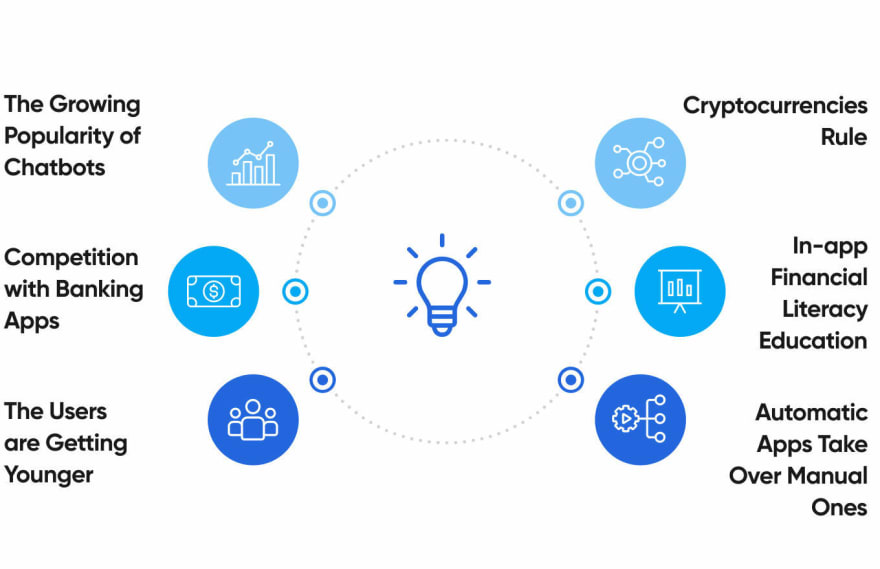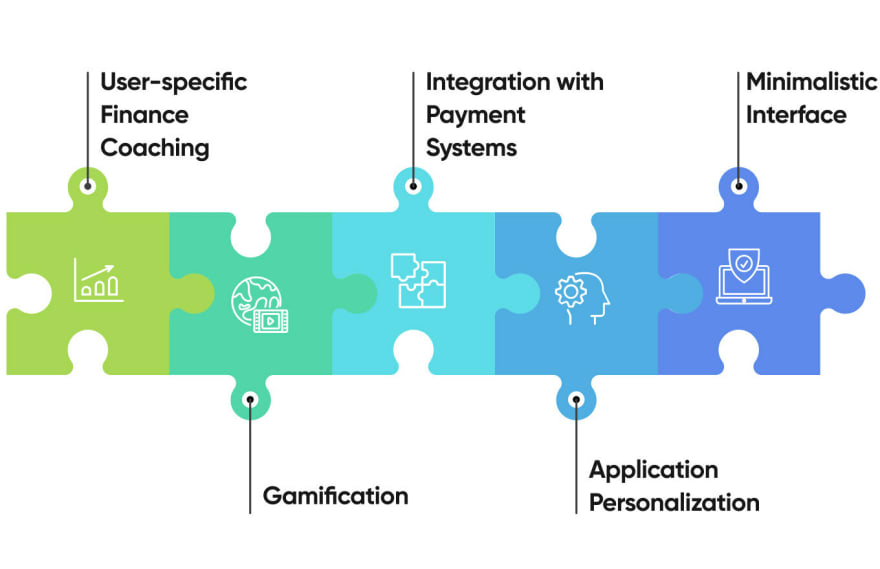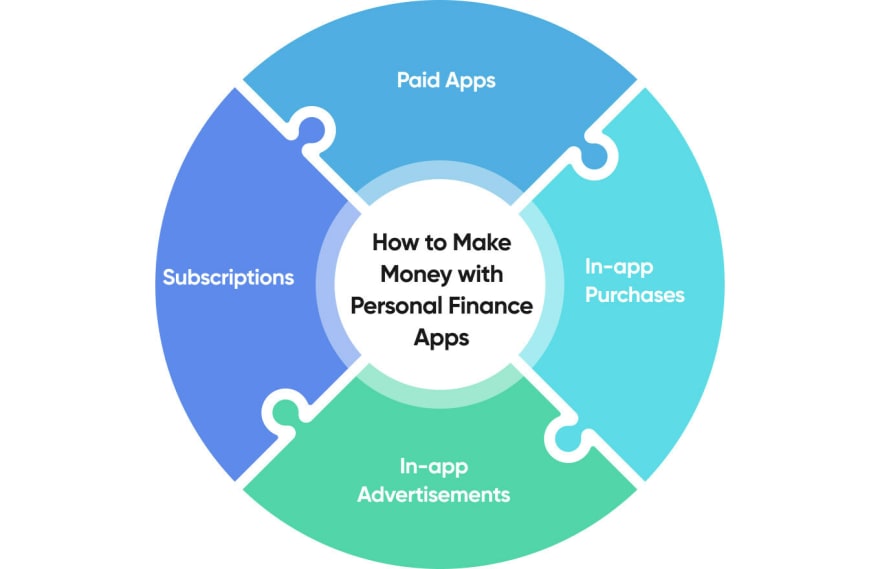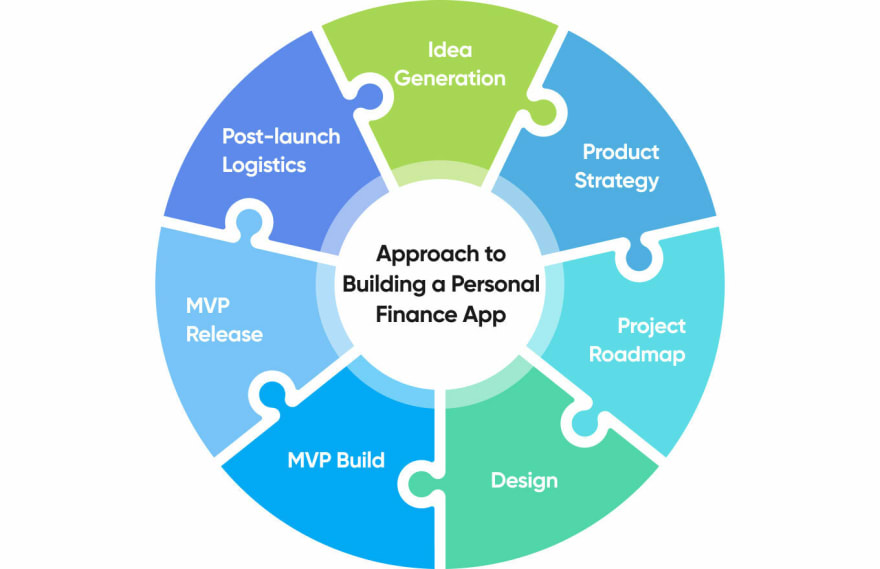The original article was written by SoftFormance https://www.softformance.com/blog/persona-finance-app-like-mint-guide/
Between 2014 and 2019, the popularity of financial apps grew by 354%, and it is expected to grow at least 1.5 times by 2026.
Why?
More and more young people reject reckless consumerism, which has been popular in the 1990s-early 2000s. Nowadays, being financially cautious is really hot.
And this trend is largely promoted through popular culture. Just check out how popular is Robert Kyosaki’s bestseller Rich Dad Poor Dad.
One of the most evident messages of this book is that rich people accumulate so much wealth because they’re inherently thrifty.
And it is a book admired by millions of people all around the world, which means that it is influential, to say the least.
Do you see where I’m going?
Right, I’m telling you that financial awareness is on the rise, and a product that supports it will definitely find its audience!
A great example is Mint, the world’s most popular personal finance management app. Released in 2007, it managed to reach 10 million in just a few years.
Despite such great success, Mint still doesn’t have too many competitors that really deserve attention.
And that’s why building a personal finance app startup in 2022 is an amazing idea!
But how to create a budgeting app and do all the things right?
This article has all the answers you need.
Here you will find a detailed overview of points to consider while building your budget app like Mint, get useful insights on what to expect from such a development project, and read what makes the success story of Mint so amazing.
Read on if you want to take advantage of the latest trends and run a truly successful startup!
A Brief Dive into Mint Success Story

The story of the Mint app started in 2006 when a young and ambitious entrepreneur Aaron Patzer left a well-paid job to take a risk and build a successful startup that would disrupt the banking industry.
He decided to run a personal finance app with a simple yet memorable name “Mint.”
Patzer released his app in 2007, and quickly gained an audience with his revolutionary idea.
However, the best was yet to come. In 2009, a promising app with 1 million users was bought by Intuit, one of America’s biggest financial software companies.
The guys from Intuit admired the uniqueness of Patzer’s idea and spent $170 million to buy an app that started as a cost-efficient digital startup.
What came next was a rapid growth of a user base (to 10 million in just a few years) and the status of one of the most popular apps finance helpers in the world.
But all these remarkable achievements would be impossible without a unique idea and clearly recognized market opportunities.
I recommend you lean canvas startup methodology as one of the best ways to detect these opportunities.
But this requires a thorough market overview.
And if you want something to start with, here’s a general overview of things you should know before you enter the market of personal finance apps.
Personal Finance App Market Overview for 2022

Let’s focus on trends that are especially relevant in 2022. We may have this list a little bit longer, but let’s leave all market insights for more specific research. These are just a few tech tips that I believe to be especially relevant.
The Growing Popularity of Chatbots
Your users will always have some questions and need answers to them.
For such cases, a chatbot is a stellar idea because it releases you from the need to hire a customer support team.
And it can provide the users with tips and other pieces of content without your need to administrate the process.
So, whether you go with a rule-based or an AI-driven chatbot, this feature will improve the user experience with your app.
Competition with Banking Apps
Banks understand the opportunities of budget apps. That’s why they introduce budgeting features in their digital bank applications.
So, the users of many banking applications, such as Alliant Mobile Banking can plan their budget and control their spending with such features.
The good news is that budgeting functionalities provided by such banking apps are, usually, no match to features of the apps that focus solely on personal finance management.
Another good thing is that you can sell your promising budget app to a bank for a very attractive price.
The Users are Getting Younger
The global population is rapidly becoming younger. This means that many users of your personal finance app may be teenagers and even kids who want to learn to manage their personal finances.
So, consider making your product attractive to a younger audience. There are many methods, such as gamification, pop culture references, educational materials, and so on.
Or you may go with a youngster-focused solution that helps teenagers learn smart spending. For example, consider the case of Greenlight.
Cryptocurrencies Rule
Around 1 billion people globally use cryptocurrencies. And this number will definitely grow.
Could there be any more significant argument for considering cryptocurrency payments while developing a personal finance app?
Make sure to integrate your platform with the cryptocurrency platform or add other features that allow your users to manage their crypto transactions.
Otherwise, you’re risking losing a significant part of your target audience.
In-app Financial Literacy Education
Nowadays, more and more budget apps provide educational value to their users.
Whether it goes about simple tips or more user-specific financial insights based on their spending, such a feature automatically makes the app more useful to the audience.
Therefore, consider including educational tips in your budget app. At least, because your competitors, most probably, provide such features in their products.
Automatic Apps Take Over Manual Ones
Personal finance management software can be divided into two types.
There are manual apps that require the user to insert all information manually.
And more technically-advanced automatic apps that integrate with banking accounts and payment systems to count the user’s spending automatically.
The trend is that automatic budget apps leave manual applications almost no chance in the competition.
By the way, the Mint app, which is a perfect example of a great budgeting software, is a vivid example of an automatic finance management application.
6 Things that a User of a Personal Finance App Needs

Building on the previous chapter, we can come up with a list of 6 things that a user expects from a personal budget app. Let’s briefly describe each of them.
User-specific Finance Coaching
As we have already mentioned, educational tips are very important for users of personal budget apps.
And the more personalized these tips are, the better.
Consider integrating your finance app with analytical tools and AI algorithms that will provide client-specific tips and suggestions based on the analytics.
Python language will become a great solution for building such AI algorithms.
Integration with Payment Systems
As we have already mentioned, the users of personal finance apps prefer processes to be automated.
If you don’t want your customers to upload various receipts into the application, integrate it with banking apps and payment systems.
In this case, all the information on incomes and spending will be automatically uploaded into your app.
And don’t forget about payment system integration for the users who purchase some premium features in your application!
Minimalistic Interface
Never underestimate the value of UI/UX design!
Even if you want to deliver an app packed with an extreme list of various features, you should keep the design as minimalistic as possible.
Just remember that the youth (and not only the youth) hate the overloaded interfaces of the early 2000s with hundreds of buttons and icons randomly placed all over the screen.
Gamification
Let’s return to the question of the young audience one more time.
To be attractive to such an audience, software should bring them fun and competition.
Therefore, gamification is a great idea. Moreover, there’s nothing really challenging about implementing it.
No need to reinvent the wheel, just add a system of in-app tasks, challenges, or bonuses.
Preferentially, add a social element as well. In this case, there may be leaderboards for friends and random people.
Just let them complete who passes more finance literacy lessons (if your app provides ones) or donates more to charity.
Application Personalization
I’ve already mentioned the value of personalized tips and suggestions.
But app personalization goes far beyond this.
Personalized greetings, interface customization, and app adjustment to specific user preferences – all these things matter.
So make sure to consider such features while designing a budget app that your user really needs.
Features to Include in the Mint-like App and How Much Will it Cost You?

Now, it is time to go from more general insights to a specific list of features that should be included in a personal budgeting app. Here’s the list of must-have functionality for all those who wonder how to create a budget app.
User Account
So, the first thing any personal budgeting app should include is a user account. It is all about the profile where a user can add personal information and review the relevant information.
Basically, it is the core of an application. And all other parts that will be developed further shall be connected to this user profile.
One more vital thing about a user account is the basic user authentication principle.
Actually, there may be many things to do at this stage, so developing a quality user account may take from 1 to 2 weeks.
Fetching Transactions from Bank Accounts
Implementing this feature may be challenging, and some finance platform developers avoid it.
However, if you want to run a user-friendly automated budgeting platform, transaction fetching is a must.
Here it goes about connecting your platform to various banking accounts and payment systems so that the app will receive enough data on your income and spending.
It may take up to a week to fully design this feature.
Financial Goals Section
In most personal budgeting apps, a user can set their financial goals and limits.
Later, he or she may keep on adhering to these goals. And don’t forget about challenge mechanics that come into action if the app is gamified!
Anyway, there will be a section that shows spending limits and a user’s adherence to them.
And it may take 3-4 days to implement such a feature.
Analytical Features
If you think of how to create a budget app that provides the user with relevant stats and projections, analytical features are vital.
Sometimes, it goes about integrating the app with existing analytical software, but there’s still much customization to go.
So, building analytical mechanics and making it run smoothly with other app financial features may become a challenge.
Nothing tragic, but it takes some time. From our experience, around a week.
Dynamic Reporting
Here’s one more task for around 6 days of active development.
One thing is to add analytics, but another is to make the results of the analysis accessible to a user.
That’s when dynamic reporting comes into action.
Again, integrating the app with an existing reporting solution may work.
But there’s still much room for customization if you want to make reports truly insightful and convenient to the users.
Mechanics for Recording and Storing Expenses
After each transaction, there remains a bill or a receipt.
And, sometimes, there may appear a need to review these “papers.”
For example, in case you want to return a recently purchased jacket that is too small for you.
The best personal finance management apps allow you to store such receipts and retrieve them when needed.
But, surely, there’s developers’ effort behind such functionality
From our experience, implementing such storage mechanics will take around 5 working days.
Schedule with Payment Reminders
An interactive schedule is a very important feature for a personal finance app.
Time frames are vital for any sort of analytics, whether it goes about spending or creating spending limits.
But it can also provide useful payment reminders to those users who should do monthly rent payments, credit payments, and so on.
So, a customizable and dynamic calendar where a user can add events and reminders is a very useful feature for a budget app.
It will take around 4-6 working days to implement it.
Push Notifications
If you have a calendar, you need push notifications as well.
These are the notifications that will appear on the user’s home screen once he or she receives a reminder.
Actually, it is not the most challenging part of creating a budget app.
However, it is important to make notification mechanics as convenient as possible.
One more valuable thing is taking into account UI/UX design considerations.
Doing all things right may take around 2-4 days.
Financial Projections
A personal finance app may require a separate tab with financial projections.
It should be connected with a built-in analytical tool and, probably, work with the dynamic reporting system.
As long as most work on this feature has been done before, its development may be not too challenging.
From my viewpoint, it is a 1-2 day task.
Saving Tips
Here it goes about the app’s educational value.
It may provide the users with useful tips on saving money and becoming more cost-efficient.
You may go with rather general tips displayed somewhere in the application’s tabs.
In this case, the active development task shouldn’t take more than 2-3 days.
However, if you want your app to provide more personalized tips, you should go with more complex mechanics.
Probably, you should even consider AI-powered solutions.
In this case, developing such tips will be a much more challenging task.
It can take developers up to a month. Everything depends on the complexity of AI features and mechanics you include.
Security Features
As long as we’re talking about an app that deals with finances and finance-related data, security is a great concern.
That’s why developing all the required safeguards is mandatory.
And it may be a hell of a task because there are so many points to consider!
All in all, application security development may take up to two weeks.
Architecture, DB, Design, and other Fundamentals
I have discussed some valuable financial app features, but I should also mention the fundamentals.
Architecture, database development, and even design may be not as recognizable as app functionality.
However, no software can exist without these essentials.
And their implementation can take quite a long, depending on your app’s complexity.
Let’s take a term from two weeks to one month.
So, what we get here, is roughly, around 130 days of active development.
This means around 1040 hours. At a rate of $60/hour, the project will cost you $62 400.
Surely, these estimates are very basic. Many tasks may be completed much faster, while there may also appear additional tasks that will make a project even more durable.
Hence, the development of a budgeting app like Mint finance manager will, most probably, cost you $40,000-$80,000.
How to Make Money with Personal Finance Apps?

So, this part was, primarily, about expenses.
But how about the more lucrative side, namely your opportunity to raise money with a personal finance application?
Here are the basic monetization models for such an application.
Paid Apps
Users will buy your app for a specified sum of money. Just make sure to attract them with a free version and provide a product that is really worth its cost.
In-app Purchases
I believe that this approach to application monetization is the most popular nowadays.
Attract the user with the app’s basic functionality and make them buy in-depth extra features.
In-app Advertisements
This approach is also very popular nowadays. You may load the application with various ads from companies that pay you.
Ideally, these ads should be personalized according to your user’s buying habits.
But be cautious with those ads. There’s always a risk of making your app too annoying for the users.
Subscriptions
Make users subscribe to your app to unlock its main features.
You may also add different subscription types that will define what your user receives.
A Step-by-step Approach to Building a Personal Finance App

It seems that I have been including our 7-step product development approach in almost any article.
But what can you do, if this methodology is basic for us and can be applied to any app development project?
So, as usual, I’ll leave the link to the article on our product development approach for those who want a more detailed description of how to make a budgeting app.
And I will leave a more general description of the 7 steps for those who want to focus on this article.
So, here are the basic product development stages we follow at SoftFormance.
Idea Generation
The first step is all about generating the idea. Here it goes about defining project basics without diving too much into detail.Product Strategy
Here we make the most valuable decisions on how to implement the idea.Project Roadmap
This stage is about more detailed and deliberate planning on how to make an idea a reality. Actually, this is the most valuable step for the project’s practical organization.Design
Here we make the basic decisions on the app’s UI/UX design. This step defines the application’s look and user experience with this product.MVP Build
We create finance application minimum viable product (MVP). It is the product’s early version with the basic functionality.MVP Release
Once the MVP is developed, it’s time to release it to a narrow audience. The most important thing here is to collect early user feedback and improve the app according to it.Post-launch Logistics
If you think that everything ends with a product release, I must disappoint you.
It’s only the beginning because there are so many tasks to be done!
The app should be constantly optimized, upgraded, managed, and monitored. And all these efforts go as the 7th step in our methodology.
10 Examples of Successful Software Similar to the Mint App

Now that you know the most valuable insights on the personal financial app and its story let’s take a look at some more examples.
These are, basically, Mint’s main competitors.
Although I’m pretty sure that they mostly lag behind Mint, these finances apps still deserve your attention.
Acorns
It is an investing app that teaches its users financial literacy.
Acorns offers the users various investment options and helps them save every cent of a spare change.
As a result, Acorns proves to be a perfect hybrid of an investment and a personal budgeting app.
You Need a Budget (YNAB)
It is a perfect solution for a user who wants to manage future expenses more efficiently.
Once a user gets paid, he or she can create different spending categories and efficiently plan expenses for a month.
YNAB is not the best solution for those who want to track past expenses but a perfect solution for future-focused users.
Qapital
Qapital is a perfect budget app for people who are trying to save money for something really BIG.
The app finance mechanics help users save funds for one or more goals.
There’s also an opportunity to unite with other users and work together to reach shared goals.
Albert
Albert is known as one of the best apps for personal finance. It is a great example of a feature-rich personal finance application.
This software helps you save money, track your expenses, and plan your budget.
And it also offers human-assisted personal finance advice.
PocketGuard
It is a great solution for those people who’re into simplicity.
PocketGuard offers a minimalistic design, as well as is rich in functionality.
For those who need even more budgeting features, there’s an option to buy a paid version.
Mvelopes
One more example of a great budgeting app with rich financial planning and expense tracking functionality.
The main drawback of this application is that you should buy a subscription to get any of its features.
Fortunately, you may try a one-month free trial.
EveryDollar
Here’s a really big name in the market of personal budget apps.
EveryDollar provides standard finance planning features, along with personalized spending tips.
It also offers a great user experience across various platforms.
Just mind that its premium version is rather expensive.
Goodbudget
Here’s a great app for those users who need help with planning their expenses.
There are useful financial projection features and an opportunity to create and track various spending categories.
Besides, Goodbuget enables the user to connect numerous devices in a single expense-planning network.
But this feature is available only to the owners of paid premium accounts.
Honeydue
Honeydue is a perfect choice for partners.
The app enables different users to create a shared budget or track each others’ expenses.
Besides, Honeydue provides payment reminders and includes a messenger for more efficient communication between partners.
Fudget
Here’s one more personal finance planner that is extremely convenient to use.
The app doesn’t aim to provide its users with extremely complex functionality.
However, it stands for an intuitive interface and the basic finance planning features that make personal budgeting simpler than ever.
Summary
So, let’s summarize the most important insights from this article.
Software similar to the Mint app is demanded in the market, and if you follow the trends and give users what they want, it won’t take long for you to start gaining profits.
But to cut all the corners, you absolutely must find the right technical partner.
And SoftFormance, a company with 200+ successfully completed projects, is ready to become such a partner for you.
We have solid experience in developing fintech solutions with the most accurate analytical mechanics.
To name a few, I will mention Solvenzio and Revenue Compass, but you may check out our portfolio for even more interesting projects.
So, if this article has brought you inspiration or just a glimpse of an idea, make sure to share it with us.
And we will find out how we can make it a reality and help you take your winning niche in the budgeting app market!



Top comments (0)